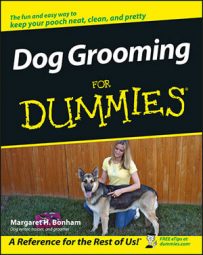When you begin a grooming session, your dog probably won't understand that it's ultimately for his benefit — even if you try to explain it to him. He is, after all, a dog, and dogs don't come with the knowledge of combs, brushes, shampoo, and nail clippers.
Because you can't simply sit your dog on the couch and rationally explain grooming to him, you pretty much have to leave him in the dark about why it has to be done. You can, however, make your dog comfortable with tools and procedures simply by minimizing the scary and painful sides of grooming as much as possible and giving rewards and praise for behaving in the right way.
You go about this task by desensitizing your dog to smaller grooming issues that won't bother him as much by doing the following:
- Choose a time when your dog is a little tired and maybe a little hungry. You want your dog to be willing to stand still for a while and to accept food from you when you want to initiate a grooming procedure, such as brushing or toenail trimming. However, you don't want your dog so tired that he's falling asleep.
- Find a quiet place around your house where you can spend some time alone with your dog. The room in which you plan to groom your dog needs to be in an out-of-the-way area where neither you nor your dog is distracted.
- Pet your dog gently all over his body. Observe his reactions as you touch his legs, the sides of his body, his face, his tail, and his rear end.
- Give your dog small treats as you pet him. These morsels provide a distraction for your dog when you're touching him in areas he otherwise may find worrisome or uncomfortable.
- If your dog shows signs of sensitivity or nervousness when you touch a particular area, don't push it. You may be tempted to insist on touching the spot your dog's reacting to harder, but don't. Lighten up on the pressure to find out whether the nervousness continues or abates. If it continues, move to another section of the body that he's more comfortable with you touching. As your dog relaxes, you can try to go back to the sensitive area with a gentler approach.
- Keep the petting sessions short — maybe one to two minutes, tops. The length of these initial sessions isn't as important as the frequency. Intersperse them frequently throughout the day.
- Gradually increase the length of the petting sessions as your dog relaxes and begins to enjoy them. You can also move the petting sessions into your grooming area, if you haven't done so already.
- Get your dog used to grooming objects; for example, run a brush or comb through his fur and against his skin. Start with a soft slicker brush, substituting it for your hand and repeating the petting routines described earlier in this list.
If your dog is fearful of grooming procedures, you need to make the petting and brushing sessions extremely short at first. Use treats to coax your dog's attention away from the slicker brush so that he focuses instead on the food you're giving him and the pleasant sensation.
Whatever you do, don't push the sessions any longer than your dog can stand. If your dog reacts adversely to them, start out by holding a treat and letting him nibble at it. While he's distracted (tricky, eh?), slowly and gently use the slicker brush, praise him when he's reacts positively, and then stop. Work up to longer brushing sessions slowly.

